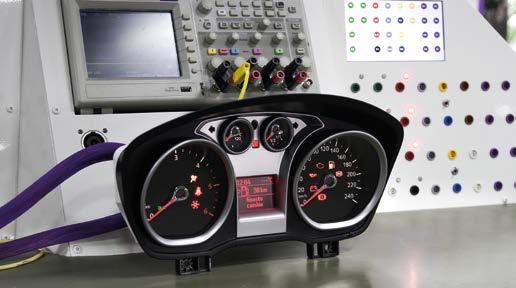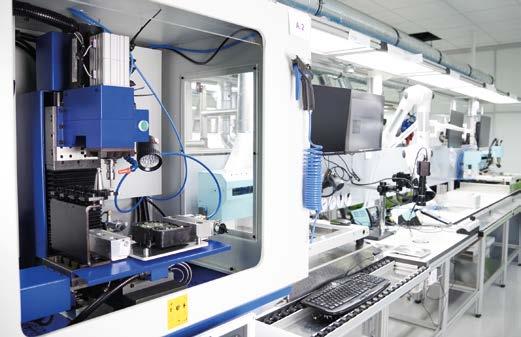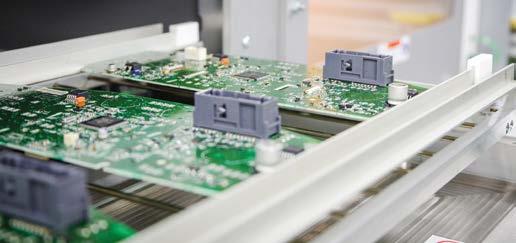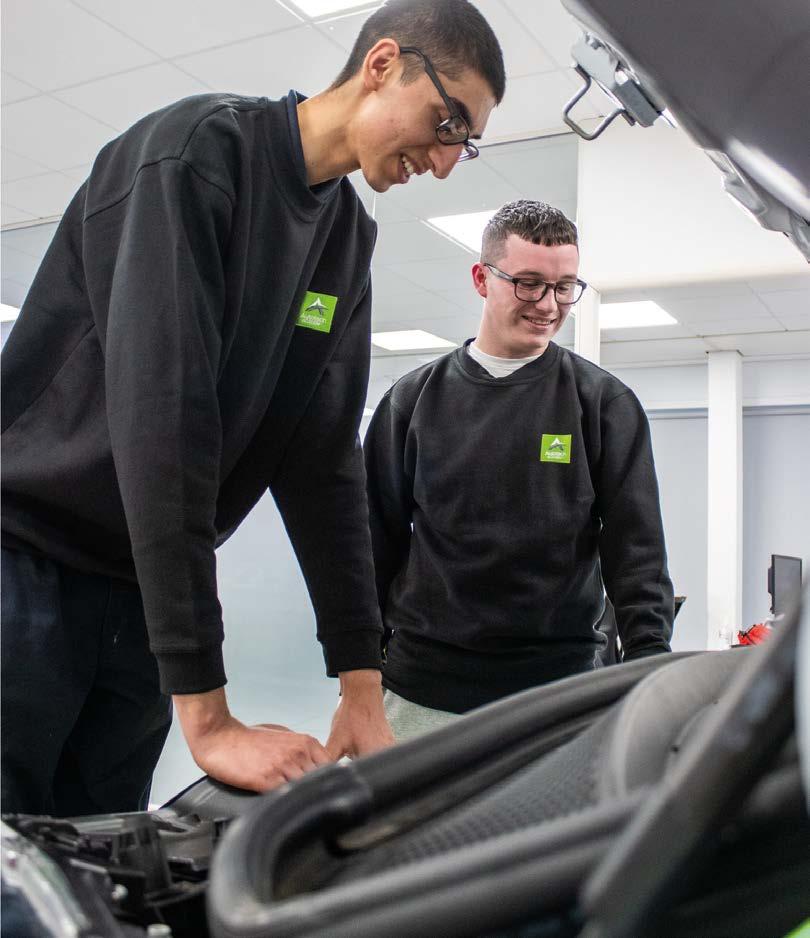8 minute read
Why everyone should consider remanufacturing
Next Article
The complexity of modern vehicles makes it increasingly difficult for car mechanics to determine the cause of a technical problem. To make matters worse, replacing modern electronic components regularly requires extensive procedures. So, what if there’s a partner that can provide you with much needed technical advice and will also repair the component for you?
With this in mind, let’s walk through the remanufacturing process at ACTRONICS, specialists in the remanufacturing of electronic automotive components.
Diagnosis and removal
As mentioned above, modern vehicle technology can be quite complex and while training options are endless, you just can’t know every little detail. So, when things get difficult, wouldn’t it be useful to have a specialist like ACTRONICS as a partner, who can help you both diagnose and solve the problem?

It was precisely this thought that prompted us to start making technical documentation. Besides the countless online articles and fault code lists on our website, we’ve also launched two diagnostic guides: A 120+ page book about transmission control units and a 150+ page one about the ABS/ESP braking system. It contains technical information, diagnosis tips and instructions on how to remove and re-install the part properly. Our customers can download or order a copy in their online account. This initiative has been so well received that we are developing other editions as well.
Of course, when documentation isn’t sufficient, you can always call customer service. Our product specialists will help you out.
Or alternatively, choose the ACtronics pick-up service and we’ll have the package collected from your workshop.
Stay informed online
From here on, everything is taken care of for you. The current status can be tracked in real time on ‘My account’ on the website and you will also receive status updates by email. Of course, we will always contact you should any issues arise.
Testing, repairs and final inspection
Why would you limit to repair if there is a better alternative like remanufacturing? That’s quite the statement, but there are some major differences between the two. Where “repair” could be explained as a single action, “remanufacturing” is more like a whole process. At ACTRONICS, remanufacturing consists of testing, all recommended repairs (not only the one that solves the current problem) and a final inspection.
Testing
In general, any weaknesses in an electronic component do not always appear during the preproduction test period, but only after several years of everyday use. Because manufacturers have already shifted their focus to newer products by then, these weaknesses are often no longer corrected. This presents an opportunity for remanufacturing specialists like ACTRONICS, because we can analyse these weaknesses in detail and improve the product where necessary. In many instances, a remanufactured product is therefore even more reliable than a new one. This is also the main reason why we have a testing phase at ACTRONICS, where a part performs an automated script (simulation) that will expose any problems. Any underlying issues will certainly be noticed.
Packing and sending: The start of a well-organised process
When determined the part is faulty, the next thing to do is pack and send it to ACtronics. Because our process is largely automated, this is a very important part of the process. It consists of four simple steps:
1. Register the part for remanufacturing on our website
2. Print out the Remanufacturing Order Form (ROF)
3. Pack the part
4. Send the package
All recommended repairs
At ACTRONICS quality is top priority. This is reflected in the way we perform our repairs as well. Each remanufacturing solution has its own protocols and where possible, improvements are made. We’ve even launched two fully automated remanufacturing lines last year, using vapor phase soldering, pick and place machines and glue robots. We are very proud to have come this far, but of course we’ll keep on improving.
Final inspection
No part will be shipped back to the customer unless a successful final inspection is completed. It uses the same automated script as entry testing, but the part must also pass a visual quality control.

Back into the car: Plug-and-play?
And that’s it, just put the part back into the car and the job is done. But is it?
Encrypted components
For various reasons, car manufacturers are increasingly encrypting electronic components. This is making it increasingly difficult to replace these parts. Programming a new component often requires special (expensive) equipment as well as specialist knowledge of the procedures to be carried out. In these cases, it is therefore much easier to have the defective part remanufactured because it preserves existing configurations and minimises the need for re-learning. This saves valuable time as well. So yes, in most cases, putting back a remanufactured part really is plug-and-play.


Software updates
As is the case with PC’s and mobile phones, the electronics used in the automotive sector are also increasingly provided with software updates. This is common practice to ensure the existing functionality, but also for tightening up on environmental requirements or solving any problems found. Unfortunately, you will lose these updates as soon as a new component has to be installed. Of course, it’s possible to update these parts, but the procedures for doing so can be cumbersome. All of which makes remanufacturing a very interesting option.
Installation instructions
However, even putting back a part without programming and updating can be a complex process. To help you further and provide you with information after the remanufacture has been completed, we will supply you an installation instruction if necessary. And of course, you can also use our diagnostic guides.
The end-result: An eco-friendly solution and a satisfied end customer
So, all things considered, remanufacturing at ACTRONICS really is a great solution. Not only do we like to think along with our customers, but choosing remanufacturing is also a good step towards a circular economy. And, as a bonus, remanufacturing also reduce costs in comparison to replacing the part for a new one and this obviously has a positive effect on the overall repair costs: A satisfied end customer. 01206
• Business peaks, annual leave, training days and sickness cover
• Fully qualified and vetted vehicle technicians and MOT testers
• Contracts lasting from one day to six months at a time
• UK-wide network of over 450 contractors
• Flexible work patterns: early, late, night & weekend shifts SHORT-STAFFED?
WE PROVIDE RELIABLE TEMPORARY COVER FOR ABSENT TECHNICIANS AND MOT TESTERS IN YOUR WORKSHOP.
Contact us today to book your contractor!
Tel: 01234 432988
Email: hello@autotechrecruit.co.uk Web: autotechrecruit.co.uk
NEED FRESH TALENT FOR YOUR WORKSHOP?

TAKE OUR INTERN TO CHECK THEIR POTENTIAL AS A PERMANENT EMPLOYEE.
• 6 to 12-month paid internships are a new, risk-free way of bringing new talent to your workshop
• Vetted candidates with a recent IMI Level 3 automotive qualification, equipped with a starter toolkit, basic safety workwear and uniform

• Assess your intern’s skills and work ethic before commiting to bringing them on as a permanent employee
• Over 200 candidates ready for an immediate start
We have interns ready to fill roles. Get in touch today!
Tel: 01234 432988
Email: hello@autotechacademy.co.uk
Web: autotechacademy.co.uk
MAZDA CX-60 E-SKYACTIV D
While a fair few manufacturers are lumping all of their technologies into one electric basket, many Japanese makers take a more considered approach. Mazda is one such company that believes that diesel is not (yet) dead and is relevant for drivers that require a workhorse that is capable of more than just the school run.
Debuting in this year's CX-60 SUV, Mazda says that the e-Skyactiv D is a further evolution of diesel engine technology. While its 3,283cc and inline six cylinders make the engine appear decidedly unfashionable, and highlights that the era of downsizing is over, it is capable of 44mpg and weighs the same as Mazda's existing 2.2-litre four-cylinder unit. Furthermore, it can be fed on a diet of biodiesel and Mazda is confident that it will exceed all forthcoming emissions requirements. The CO2 outputs of 127g/km (200PS), or 137g/km (254PS) are especially
LEXUS ES – DIGITAL SIDE VIEW MIRROR

credible, considering the unit's displacement and power output. The CX-60 also has a 2,500kgs towing capacity.
Much of these achievements are down to the DCPCI (Distribution-Controlled Partially Premixed Compression Ignition). While Mazda is keeping tight-lipped on further technical details, the system relies on multiple fuel injections that enable a pre-mix of the diesel and air upon interaction with the egg-shaped recess on the piston crown.


Yet, this unit is also a hybrid, featuring the Mazda M Hybrid Boost. While the mild-hybrid system's lowly 48-volts rating will limit its abilities, at least technicians will not require highvoltage health and safety training. As the diagram shows, the hybrid system appears to act on the transmission, rather than on the engine's FEAD drive. As such, it should be relatively maintenance-free.
Digital side mirrors are nothing especially new, even to Lexus. The Japanese brand offered them originally in 2018 for its domestic market, a world-first for a mass-production car, prior to offering them to UK customers a little over two years ago. Interestingly, for our market, the system has been revised to ensure that clearer images are displayed in poor light conditions, such as when driving in rain... Lexus claims that safety is the main advantage. The system sees traditional door mirrors replaced with compact, external, highresolution cameras, linked to in-car monitors. They provide an enhanced view of the area behind and immediately alongside the vehicle in all weathers, with Lexus claiming that they are protected against snow, water and dirt. Their wider angles also reduce blind spots. They are also adaptive and change their field of vision, when the car is turning, or reversing. Furthermore, the smaller housings reduce the chance of impact damage. Lexus also highlights aerodynamic advantages that help lower the all-important CO2 emissions. Perhaps, this is the real reason...
Audi Urban Purifier

Finally, while we do not tend to feature pilot technologies, we thought that this interesting project between Audi and Mann+Hummel filtration was worth highlighting. Audi admits that, regardless of a vehicle’s drive system, 85% of fine dust in road traffic is caused by particulates from the brakes, tyres, or road. These smallest particles, which are virtually invisible, are only a few micrometres in size and these cancer-causing fragments can be inhaled easily.

Yet, in the last year, the World Health Organization (WHO) has recommended significantly lower particulate matter limits are set but, according to experts cited by Audi, it would be impossible to comply with these new values in many German towns and cities. This is worth considering, because future Euro VII legislation is targeting these types of emissions.
In any case, a filter is fitted to the front of Audi e-tron test cars to absorb not just its own particulates but also those of other vehicles. The filter is fitted in front of the radiator and is controlled by a switchable cooling air inlet. Using a similar principle to that of an engine air filter, the purifier filter traps particulates from the incoming stream. While the system works using ram air, when the vehicle is moving, the radiator fan also drags air through the purifier, when the car is either stationary, or moving slowly in traffic.
While two years of testing remain, Audi reports that the filters have no negative effect on the operation of the electric vehicle, including on hot summer days or during fast charging. The partners are also investigating working with weather stations and an interior display to allow occupants to control the system and evaluate its effectiveness.

